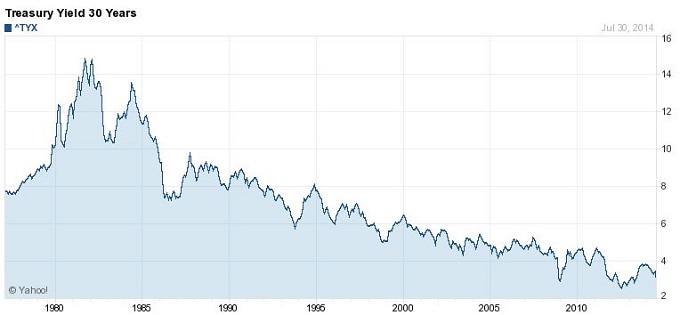An Annuity Ladder May Help You Ease Into an Annuity Purchase

If you've been thinking about buying an annuity recently, you must be used to seeing your hopes for higher interest rates dashed. Even the best economists have been wrong in their forecasts lately, predicting rates to rise, then forced to announce further delays as new economic data emerges.
I speak with consumers about interest rates nearly every day. Last week, I had a chance to discuss rates with a well-known former CFO friend of mine, when the two of us and our wives went to dinner in Manhattan. Here's how our conversation went:
First, some background. Mark B. and I went to NYU together in the 70s. Mark is 64 years old. He's been thinking about buying an annuity for quite a while. In fact, I think he first mentioned it to me four years ago.
Even though an annuity made sense for Mark’s retirement portfolio when we first discussed it, he continues to hope that if he waits just a little longer, interest rates will be higher than they are today.
Mind you, Mark would be relatively pleased with his payout if he bought an annuity at today’s rates. It's more about his personality -- Mark is hesitating because he’s the kind of guy who hates to lose. He worries if he locked up his money at today’s rates, he'd regret knowing that he could have done better next year.
Obviously, the big risk to Mark’s approach has been that interest rates have continued to drop while he's been waiting for them to reverse higher. In fact, in the past four years, anyone who's been waiting for rates to turn up, has been disappointed. Take a look at this interest rate chart on Yahoo:

(Click here to see the current chart)
You can see that interest rates for the 30-Year U.S. Treasury Bond peaked in 1982 at 15%. Since then, you would have done better to purchase your annuity when you first started your research than waiting a year or two more for interest rates to move up, which didn't happen.
Of course, you wouldn't have known that rates would be heading lower. Which raises an important question: How do you know that it's the right time (interest-rate-wise) to buy your annuity?
With daily predictions that "rates will rise," always a year away, what should you do now? There is an approach you can take that side-steps the interest rate uncertainties. It's designed to create your retirement income portfolio in stages. I call this the "climbing an annuity ladder" strategy.
So just what is an annuity ladder?





We'd love to hear from you!
Please post your comment or question. It's completely safe – we never publish your email address.
Comments (10)
dave
2014-10-28 20:19:10
I don't under stand it when you say "staggered maturity dates: ten years, seven years, five years, and three years. Then at the end of three years, when your first annuity matures, you can roll it over into a higher-yielding contract (if rates have moved up)." say you buy one for 5 years, what are you getting during those 5 years and what amount of the principal do you get at the end to 'roll over' again?
Hersh Stern (ImmediateAnnuities.com)
2014-10-31 14:49:19
Hi Dave--
Your question references multiyear deferred annuities. So first I'd like to tell you how they work. This type of annuity is similar in structure to the certificates of deposit that banks sell but without FDIC protection. So if you invested in a 5 year multiyear deferred annuity the insurance company would credit your premium for 5 years with a set annual interest rate. You could let the interest grow in the annuity or you could withdraw the earned interest periodically, usually without penalty. As an example-- assume you invested $100k in a 5-year deferred annuity that paid you 2.50% interest a year. Each year you'd earn $2,500 in interest. Ignoring the effects of compounding interest, at the end of the 5 years your account would have grown from the original $100k to $112,500 (that's $100k plus 5 times $2,500) if you had not removed any of the interest during the period. The $112,500 would be available to you to withdraw without insurance company penalties. You could also leave it with the same company for another 5 years, or roll it into a different company's product, if you'd like. (You could even convert the cash value into a lifetime income.)
The key to the concept of laddering is that as each annuity matures, you are able to roll it over into an annuity with the same or different maturity date at the then going interest rates. So if interest rates head up from here, you'd be rolling your maturing annuities into new ones that earn more interest than your current annuities pay.
Keep in mind that this is a very general explanation of the concept of laddering annuities. If you'd like help with your particular situation call our consumer service line at 800-872-6684. We'd be glad to speak with you about your plans.
Bob
2015-11-24 15:58:46
I've read and inquired so much my head is spinning. But still can't pull the trigger.
Hersh Stern (ImmediateAnnuities.com)
2015-11-24 16:00:22
Hi Bob-
It's a very common sentiment and I hear it frequently from consumers buying their first annuity. Your hesitation is legitimate. There are so many angles to consider and nobody likes to buy the wrong product, especially when the cost is thousands of dollars!
The gist of the above blog is that there's a path you can take to resolving this hesitation. Divide your premium into smaller portions and buy a smaller annuity than you are initially planning to. Consider it a small experiment.
Ultimately, there are only two possible outcomes:
1. You'll realize that you were correct to hesitate and that annuities are just not for you. In which case, you only "blew" a fraction of the amount you have to invest so you saved yourself from a much bigger headache.
2. You'll like the experience and feel good about your purchase. You'll even be emboldened to try it again with another portion.
I believe this is a reasonable approach to take.
Hersh
Gail
2016-02-24 14:52:20
I'm 78 years old. Is it best to wait until next year to buy an immediate annuity when interest rates might increase? Does the rate increase slightly as I age? Or maybe take the money sooner and save them so it balances out at 80 plus?
Hersh Stern (ImmediateAnnuities.com)
2016-02-24 14:53:56
Hi Gail-
There's no simple answer to your question of whether or not to wait to buy your annuity. Of course, if interest rates increase by next year and you buy the annuity then you'll have a higher monthly payment for life (assuming insurance company life expectancy calculations don't increase too). Also, your being a year older will tend to bump up your income about 2%-3%.
On the other hand, what happens if rates stay the same or decline (which is what they're been doing for the past 30+ years)? Then you would have lost a year's worth of monthly payments which you can never make up. Plus you'll be locking in a lifetime of lower monthly payments.
Lastly, you need to consider what your money would be earning (in a bank, a bond, or the stock market) while you wait to buy your annuity versus the return your money would earn if invested in the annuity (i.e., the annuity's internal rate of return).
Hersh
Edward
2016-02-25 13:07:00
Money comes from traditional IRAs (mine and my wife's) and from after tax savings. (50/50%)
Hersh Stern (ImmediateAnnuities.com)
2016-02-25 13:07:43
Hi Edward-
Several quick notes here - the same rule which prohibits you from comingling your IRA and your wife's IRA in one "family" IRA account, disallows you to fund one "family" annuity using your two IRA accounts. You'll need to keep the monies separate in two IRA annuities.
Additionally, you cannot comingle non-IRA money with IRA money in the same annuity contract.
So to accomplish what you have in mind you need to apply for four annuity contracts. Ultimately the total monthly income from these four annuities should be very close to the quoted amounts you saw for one large annuity.
Hersh
Sarah
2022-09-24 07:54:04
Hello, I'm 64 yrs old and 4-6 yrs from retirement. From my workplace vendor I've been offered to invest 300K (from a 403B) in a deferred income annuity. One starts paying out at 70 at 9.36% till I'm 100. The other starts paying out at 68 at 7.75%. They also offer one with 3% inflation protection. I don't know what to do. I own my home and 300 makes up about 1/3 of my savings. What do you think? Thanks very much
Kyle
2022-09-27 10:10:48
Hi Sarah,
Thank you for reaching out!
I would be happy to discuss this plan with you. I've sent you an email follow-up, but please feel free to call me on our toll-free number, (800) 872-6684.
Best regards,
Kyle